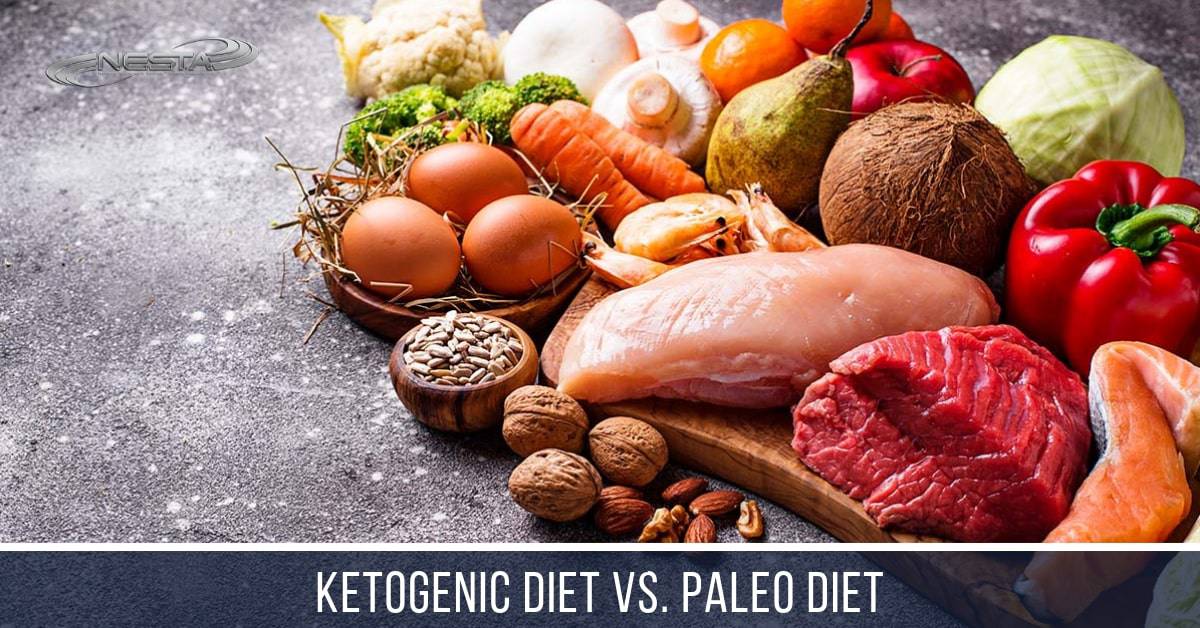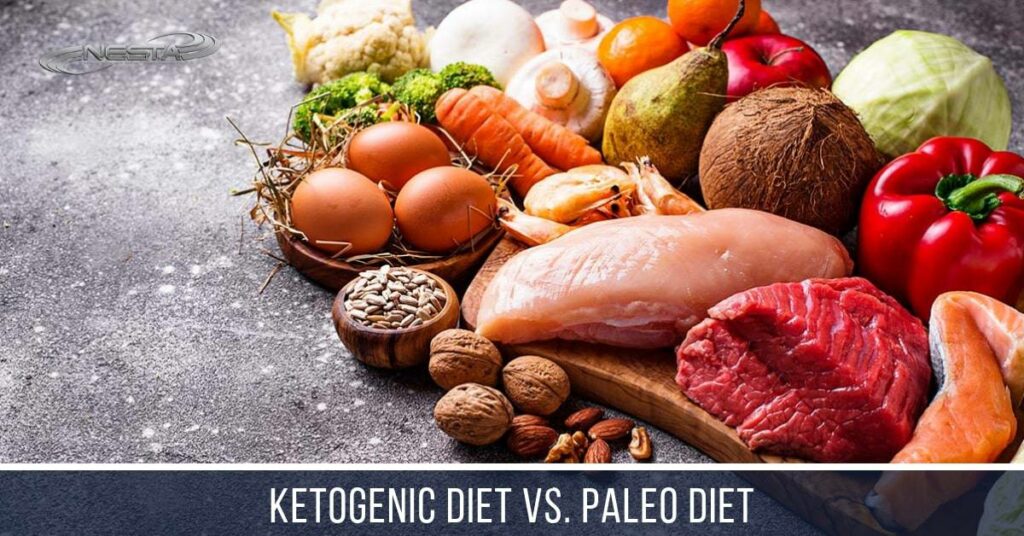 Both the keto diet and the paleo diet are a low-carbohydrate, high-fat diet, but they do have key differences that set them apart from each other.
Both the keto diet and the paleo diet are a low-carbohydrate, high-fat diet, but they do have key differences that set them apart from each other.
Science has shown benefits and risks associated with both of these diets, and individuals have reported incredible improvements with weight, energy levels, and overall health with both.
Ultimately, you should choose a diet that best suits your lifestyle and your health goals.
What is the Ketogenic Diet?
The ketogenic diet consists of a low intake of carbs, moderate intake of protein, and a high intake of healthy fats.
In terms of caloric breakdown, that means about 75% of your daily calorie intake should come from fat, 20% from protein, and only 5% from carbohydrates.
The aim of the diet is to decrease the intake of carbohydrates so that the body will eventually run out of its most abundant energy source and will begin to rely on fat as its new energy source.
As the body continues to burn fat for energy, it will eventually enter into a state of ketosis.
Fat that is metabolized in the body is broken down into fatty acids. These fatty acids are then further metabolized into specific ketone bodies.
The longer the keto diet is sustained, the more ketone bodies will accumulate, which will eventually lead the body into ketosis. These ketone bodies will be the new energy source for the body as long as the carbohydrate intake remains low.
What Are the Benefits of the Keto Diet?
The keto diet has proven to be very effective for rapid weight loss and provides a number of different health benefits, such as lowered blood sugar levels.
Studies have shown that this diet is very beneficial for individuals with metabolic syndromes, insulin resistance, and type 2 diabetes because of this decrease in blood sugar levels.
Many individuals are worried when they hear a low-carb diet because they know that carbohydrates are the body’s primary source of energy. However, ketone bodies can easily cross the brain’s blood-brain-barrier and therefore are considered an alternate energy source for the brain when glucose levels are low. In fact, individuals on a keto diet report an increase in energy levels and cognitive functioning.
Another benefit to the keto diet is that it is not a restricting diet at all. Although the intake of carbohydrates is limited, there is no restriction on the number of calories eaten, so you should never feel unsatisfied or hungry.
What Are the Disadvantages of the Keto Diet?
One of the biggest risks associated with the keto diet is that the diet itself contains a high percentage of saturated fats. The high-fat keto diet is associated with an increase in LDL cholesterol, the “bad” cholesterol, which is linked to heart disease.
Additionally, until the body reaches a state of ketosis, which may take days or weeks, the body will go through some serious “carb-cravings”, as the body is running out of its primary energy source and has not yet begun to burn fat.
Reaching and especially maintaining a state of ketosis is very difficult for many individuals, and therefore these cravings never really subside, making individuals quite irritable. Individuals often have trouble with constipation, as a low-carbohydrate diet also significantly reduces daily fiber intake.
What is the Paleo Diet?
The paleolithic diet, simply known as the paleo diet, is meant to represent a diet similar to that of our hunter-gatherer ancestors thousands of years ago.
The idea is that during this time period, modern diseases such as diabetes or heart disease did not exist because their diet was much better suited for the human species’ genetic profile than is our modern-day diet.
The hunter-gatherers ate what was available to them, which was primarily whole foods, such as meat, fish, eggs, vegetables, fruits, healthy fats and oils, spices, nuts, and seeds. All dairy, grains, and not surprisingly, processed foods should be avoided on this diet.
Because of the types of foods that are considered whole foods, the paleo diet is usually a low-carb, high-protein, and high-fat diet. The protein intake levels in the paleo diet are much higher than those of the keto diet.
What Are the Benefits of the Paleo Diet?
There have been several randomized, controlled studies conducted on discovering the effects of the paleo diet. Whether the individuals in the study were patients with type 2 diabetes, patients with ischemic heart disease, or even just healthy volunteers, the paleo diet yielded very similar results— there was a significant decrease in weight and waist circumference, as well as a decrease in blood pressure.
Additionally, the paleo diet essentially ensures clean-eating. The diet eliminates any processed foods with additives or chemicals, which leads to an anti-inflammatory environment in the body.
Inflammation is linked to the causes of diseases such as cancer and cardiovascular disease, which are the two diseases with the highest cause of death in the world. Thus, an anti-inflammatory diet can lower the risk for any of these diseases.
What Are the Disadvantages of the Paleo Diet?
Scientific studies have shown that individuals on a paleo diet have lower calcium levels, which is most likely due to eliminating dairy from their diet. If individuals are not regulating their calcium levels while on the paleo diet, this could increase the risk for osteoporosis.
The paleo diet is also a low-carb, high-fat diet, which creates a risk of increased LDL cholesterol, the “bad” cholesterol that is highly correlated with cardiovascular disease.
Scientific research on the paleo diet is still very preliminary and although there are known short-term benefits, the long-term effects of this diet have not been thoroughly studied as of yet.
Additionally, studies have shown that the paleo diet is significantly more expensive to maintain than a regular healthy diet. For low-income households, this may be a potential barrier to maintaining the paleo diet.
The paleo diet also eliminates any legumes, which may be a potential issue for any vegans or vegetarians that rely on beans as a protein source.
What’s Next?
If you want to help clients with food, diet, weight management and improving the results of their fitness routines, the Fitness Nutrition Coach course is for you. You will learn about optimal nutrition, including proven techniques for increasing energy, optimal health and decreased dependence on medications. Instantly increase your job and career opportunities with this popular professional credential.
Our programs are open to anyone with a desire to learn and help others. There are no prerequisites.
That’s it for now.
Take action!
PS: Click here to see many helpful business/career resources






